8 Common Indoor Plant Problems and How to Identify and Solve Them
In today’s fast-paced world, bringing in a touch of nature with houseplants has become popular. Indoor plants enhance the aesthetic appeal of our living spaces and improve air quality and well-being. However, like any living thing, houseplants are susceptible to various problems that hinder their growth and vitality. Here, we’ll discuss eight common indoor plant problems, offer tips for spotting them, and provide practical solutions to help your green companions thrive.
Additional watering:

One of the most common problems indoor plant enthusiasts face is overwatering. Although watering is essential to plant health, too much moisture can cause root rot and other serious problems. Symptoms of overwatering include yellowing leaves, wilting, and constantly wet soil. To avoid overwatering, always check soil moisture before watering and allow it to dry out slightly between watering sessions. Also, ensure proper drainage by using containers with drainage holes and avoid overwatering plants.
Underwatering:

Conversely, underwatering can also threaten indoor plants. Inadequate moisture can cause leaf wilting, leaf drop and stunted growth. Check the soil and water well regularly when your plant seems dry to determine if it is waterlogged. Establishing a consistent watering schedule based on your plant’s needs can help prevent waterlogging.
Inappropriate lighting:

Indoor plants rely on light for photosynthesis, the process by which they convert sunlight into energy. Insufficient or excessive light exposure can cause problems such as leggy growth, leaf discolouration and poor flowering. To solve lighting problems, identify your plants’ lighting needs and place them in appropriate locations within your home. Supplemental lighting, such as grow lights, can provide additional illumination when natural light is limited.
Post:

Indoor plants are vulnerable to attack by various pests, including aphids, spider mites, and fungi. These pests can damage plant tissue, spread disease, and stress plants. Inspect your plants regularly for signs of pests, such as yellowing leaves, sticky residue, or visible insects. Treat affected plants immediately using natural remedies or commercial insecticides, and practice good hygiene to prevent the spread of pests to other plants.
Disease:

Plant diseases, such as powdery mildew, root rot and leaf spot, can wreak havoc on indoor plants if left unchecked. Symptoms include discoloured or deformed leaves, stunted growth, and fungal growth on plant surfaces. To prevent the spread of disease, practice proper sanitation by removing and disposing of infected plant parts and avoid crowding plants to promote air circulation.
Nutritional deficiencies:

Indoor plants need a balanced supply of nutrients for healthy growth and development. Common nutrient deficiencies include nitrogen, phosphorus, and potassium, which can manifest as leaf yellowing, poor growth, and leaf drop. To combat nutrient deficiencies, fertilize your plants regularly with a balanced fertilizer for indoor plants. Follow the recommended dosage and application instructions to avoid over-fertilizing, which can damage plant roots.
Root Bound Plants:

Over time, indoor plants can become root-bound, meaning their roots outgrow their containers and become tightly packed. Symptoms include stunting root-bound plants, roots emerging from the soil surface, and waterlogging. To alleviate root-bound conditions, repot your plants in larger pots with fresh soil and gently loosen and prune the roots as needed. This will give your plants enough room to spread their roots and thrive.
In conclusion, while indoor plants bring beauty and tranquillity to our homes, they are not immune to problems. You can ensure your indoor garden thrives by regularly addressing common plant problems such as overwatering, underwatering, lighting problems, pests, diseases, nutrient deficiencies, and root-bound conditions. Remember to tailor your care practices to each plant’s needs and consult gardening experts or resources when necessary. Proper care and attention will reward your indoor plants with lush foliage, vibrant blooms, and a healthy living environment.
Read Our More Blog
Post Views: 538





